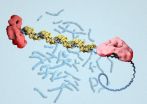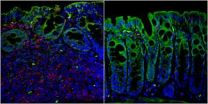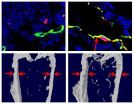Innovative stroke patient management system cuts hospital bed usage by more than 25 percent
'Win-win' program in Kelowna, BC, provides better care to patients and hospital savings of up to $800,000
2014-10-06
(Press-News.org) An innovative patient management system at the acute stroke unit of Kelowna (BC) General Hospital has reduced the number of stroke patient bed days by more than 25 per cent, according to a study of the system presented at the annual Canadian Stroke Congress in Vancouver.
In total, it is estimated the new system is saving the 380-bed hospital more than 1,000 bed days per year. This represents annual savings of up to $800,000, all achieved without the need for any new investment in devices, treatments or personnel.
"It's a win-win situation," says Dr. John B. Falconer, director of the transient ischemic attack (TIA) and stroke clinic at the hospital, and author of the study. "Patients are better and more efficiently treated, the hospital saves resources and the morale of the whole unit is much better."
The program is called Proprietary Physician, or Pro-MD. It involves assuring that one of the hospital's five neurologists is always designated as primarily responsible for best bed usage and patient flow on the acute stroke unit.
"The ward becomes "that doctor's" ward; they have a propriety interest in it functioning well," says Dr. Falconer. Each doctor's assignment as Pro-MD could last several weeks or a month.
A crucial component of the program is that beyond the normal care to the patients by their own neurologist and other caregivers, the Pro-MD makes twice-weekly rounds of all patients with the full care team. This includes the ward head nurse, physiotherapist, occupational therapist, social worker, transition nurse, pharmacist, rehabilitation ward head nurse and – very importantly according to Dr. Falconer – the patient's family.
"This brings everyone who needs to have input into decisions about a patient's care together to agree on the action needed," says Dr. Falconer. "This is very advantageous compared to formerly having to compare written notes from one another and wait for input from others."
The meetings take only 30-45 minutes to discuss the usual half-dozen patients, but result in everyone agreeing on the course of care, including the family. This is crucial, particularly when discussing the timing and terms of a patient's discharge from hospital.
A further benefit, added Dr. Falconer, has been a huge boost in staff morale on the ward. "We're now the primo ward of the hospital, with staff enjoying the team-based collaboration," he says.
The program is actually very simple but has proven very effective. "It could perhaps be used in other areas of the hospital, but it's particularly relevant to stroke care because of the many players involved and the crucial role the patient and family play in rehabilitation."
Hot Topic in Stroke: Health Systems
Given that there are about 62,000 strokes in Canada per year and stroke patients spend a total of more than 630,000 days in acute-care hospitals, the learnings from this study could have an important impact on hospitals and health care right across the country, says Ian Joiner, director of stroke for the Heart and Stroke Foundation.
"This local success story shows that savings don't necessarily only have to come from cutbacks, nor improvements in care solely from large monetary investments," he says. "They can result from just doing things smarter and more collaboratively."
He says that coordinated systems are the best way to deliver stroke care: having the right resources, in the right place at the right time.
Stroke Care and Treatment Have Improved but There Is Still Work to Be Done
Compared with five years ago, more hospitals are designated as stroke centres, more hospitals have stroke teams, more hospitals have stroke units, more hospitals are administering clot-busting drugs (such as tPA) and more hospitals have telestroke capacity. Telestroke uses various types of technology to link healthcare sites, providing diagnosis and treatment recommendations, and services to stroke patients regardless of their location.
Other improvements include faster access to CT scans and more patients being discharged home with services, or accessing in-patient rehabilitation.
"There are still opportunities for improvement at every point along the continuum of care, from prevention to rehabilitation," says Joiner. "Governments, healthcare system decision makers, healthcare providers and Canadians all have a role to play."
"Initiatives such as the Canadian Stroke Congress provide an unprecedented opportunity for health experts to get together to identify research priorities and the evidence required to share best practices which will improve the health of Canadians," says Dr. Robert Côté, co-chair of the Canadian Stroke Congress. "This study is a perfect example of a model which could be transferred to hospitals and enhance treatment in other communities."
INFORMATION:
The Canadian Stroke Congress is a joint initiative of the Heart and Stroke Foundation and the Canadian Stroke Consortium.
Statements and conclusions of study authors are solely those of the study authors and do not necessarily reflect HSF or CSC policy or position. The Heart and Stroke Foundation and the Canadian Stroke Consortium make no representation or warranty as to their accuracy or reliability.
About the Heart and Stroke Foundation
The Heart and Stroke Foundation's mission is to prevent disease, save lives and promote recovery. A volunteer-based health charity, we strive to tangibly improve the health of every Canadian family, every day. Healthy lives free of heart disease and stroke. Together we will make it happen. heartandstroke.ca
Congress information and media registration is at http://www.strokecongress.ca
After October 7, 2014, contact:
Jane-Diane Fraser
Heart and Stroke Foundation of Canada
jfraser@hsf.ca, (613) 691-4020
ELSE PRESS RELEASES FROM THIS DATE:
2014-10-06
At the first sign of a stroke, time is of the essence. For every minute of delay in treatment, people typically lose almost two million brain cells. Yet a new study presented at the Canadian Stroke Congress reveals that those delays – in getting the right tests and the right drugs – can be longer when people experience a stroke in a hospital.
Investigators from the University of Toronto Faculty of Medicine, the Institute for Clinical Evaluative Sciences (ICES) and the University Health Network looked at data from acute care facilities in Ontario over nine years. They ...
2014-10-06
Researchers at the University of Texas Medical Branch at Galveston say that sexting may be the new "normal" part of adolescent sexual development and is not strictly limited to at-risk teens. The findings, published in the journal Pediatrics, are from the first study on the relationship between teenage sexting, or sending sexually explicit images to another electronically, and future sexual activity.
The study results indicate that sexting may precede sexual intercourse in some cases and further cements the idea that sexting behavior is a credible sign of teenage sexual ...
2014-10-06
We might love to reminisce and tell others about our extraordinary experiences — that time we climbed Mt. Kilimanjaro, got to taste a rare wine, or ran into a celebrity on the street — but new research suggests that sharing these extraordinary experiences may come at a social cost. The findings are published in Psychological Science, a journal of the Association for Psychological Science.
"Extraordinary experiences are pleasurable in the moment but can leave us socially worse off in the long run," says psychological scientist and study author Gus Cooney of Harvard University. ...
2014-10-06
Children's future writing difficulties can be identified before they even learn how to begin writing, according to a new study by Professor Phaedra Royle and Postdoctoral fellow Alexandra Marquis of the University of Montreal's School of Speech Language Pathology and Audiology. The researchers are interested in oral language skills and their impact on grammar and spelling learning. Their work shows that oral language is a good predictor of writing difficulties. "The more children are able to use verb tense in spoken language, the more easily they can learn written language," ...
2014-10-06
Researchers from UCL, Stanford Engineering, Google, Chalmers and Mozilla Research have built a new system that protects Internet users' privacy whilst increasing the flexibility for web developers to build web applications that combine data from different web sites, dramatically improving the safety of surfing the web.
The system, 'Confinement with Origin Web Labels,' or COWL, works with Mozilla's Firefox and the open-source version of Google's Chrome web browsers and prevents malicious code in a web site from leaking sensitive information to unauthorised parties, whilst ...
2014-10-05
Scientists have taken pictures of the BRCA2 protein for the first time, showing how it works to repair damaged DNA.
Mutations in the gene that encodes BRCA2 are well known for raising the risk of breast cancer and other cancers. Although the protein was known to be involved in DNA repair, its shape and mechanism have been unclear, making it impossible to target with therapies.
Researchers at Imperial College London and the Cancer Research UK London Research Institute purified the protein and used electron microscopy to reveal its structure and how it interacts with ...
2014-10-05
An international collaboration of scientists has identified a fifth of the genetic factors that cause height to vary between individuals.
A study which examined data on DNA from more than 250,000 people, published on October 6 in Nature Genetics, roughly doubles the number of known genome regions involved in height to more than 400. It also revealed that more than half of the factors involved in determining height are explained by simple common genetic variation - the sort of genetic variation that exists in more than 1 in 10 people.
The collaboration, co led by the ...
2014-10-05
Researchers at University of California, San Diego School of Medicine have discovered that T-cells – a type of white blood cell that learns to recognize and attack microbial pathogens – are activated by a pain receptor.
The study, reported online Oct. 5 in Nature Immunology, shows that the receptor helps regulate intestinal inflammation in mice and that its activity can be manipulated, offering a potential new target for treating certain autoimmune disorders, such as Crohn's disease and possibly multiple sclerosis.
"We have a new way to regulate T-cell activation ...
2014-10-05
Experiments in mice with a bone disorder similar to that in women after menopause show that a scientifically overlooked group of cells are likely crucial to the process of bone loss caused by the disorder, according to Johns Hopkins researchers. Their discovery, they say, not only raises the research profile of the cells, called preosteoclasts, but also explains the success and activity of an experimental osteoporosis drug with promising results in phase III clinical trials.
A summary of their work will be published on Oct. 5 in the journal Nature Medicine.
"We didn't ...
2014-10-05
The largest genome-wide association study (GWAS) to date, involving more than 300 institutions and more than 250,000 subjects, roughly doubles the number of known gene regions influencing height to more than 400. The study, from the international Genetic Investigation of Anthropometric Traits (GIANT) Consortium, provides a better glimpse at the biology of height and offers a model for investigating traits and diseases caused by many common gene changes acting together. Findings were published online October 5 by Nature Genetics.
"Height is almost completely determined ...
LAST 30 PRESS RELEASES:
[Press-News.org] Innovative stroke patient management system cuts hospital bed usage by more than 25 percent
'Win-win' program in Kelowna, BC, provides better care to patients and hospital savings of up to $800,000


